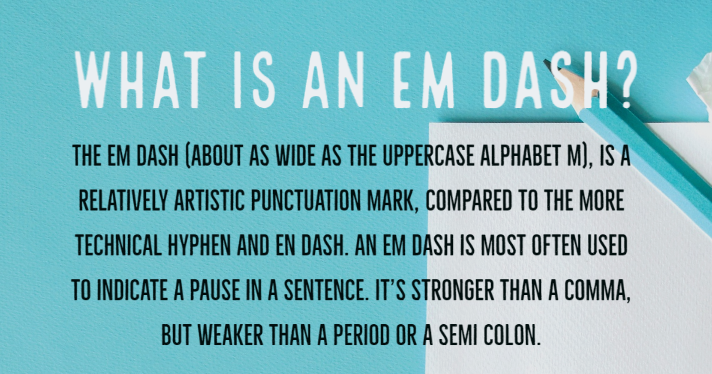They might look the same on a printed material, but hyphens and dashes are so much different from one another. For one, hyphens (-) are shorter than dashes, (—) and (–). And yes, there are 2 kinds of dashes, the Em dash (—) and the En dash (–). But that's just the beginning. If you want to keep these lines straight, then keep reading!
What is a hyphen?
A hyphen is the punctuation mark (-) used especially to divide or to compound words, word elements, or number.
Everybody knows that a hyphen is used in many compound words like good-hearted and mother-in-law. Likewise, words from twenty-one and ninety-nine should also be hyphenated when spelled out. And finally, we all know that hyphens are used to join prefixes to other words like pre-eminent and co-owner. Be warned, though, for many hyphens have perished as the English language marched on. Many words that are hyphenated in the past had been changed into one word. For example, today was once spelled as to-day, and crybaby was once cry-baby. So if you are not sure whether or not a hyphen is required, better check the dictionary.
There are few things to keep in mind when using hyphens, though! Here are some:
1. Use a hyphen with a compound modifier before a noun, but never put the hyphen when the compound modifier comes after a noun. So, it's correct to write 'a dog-friendly hotel', but not 'a hotel that is dog-friendly'. It should just be 'a hotel that is dog friendly.'
2. Don't use a hyphen when you have a compound modifier that consists of an adverb ending in -ly plus a participle or adjective. The ly is sufficient enough to show that the compound is a unit of meaning. For example, write 'a highly respected researcher', not 'a highly-respected researcher.'
3. When you are writing a compound modifier that is interrupted by some other word that's not really part of the modifier, use a suspended hyphen: Take a five- or ten-minute break.
What is an en dash?
Ah, the not so popular en dash. We're using it as often as the hyphen, without really calling it properly by its name. En dash is the punctuation mark (–) which is often used in writing expressions that has number in it. It is said that it's called an en dash because the length of this punctuation mark is the same as the width of the uppercase alphabet N. Oh, and don't you know that you can type the en dash on your computer keyboard by pressing Alt+0150? You're welcome. And oh, the numbers should be typed on the numeric keypad, not the numbers on top.
Here are the uses of the en dash:
1. Use an en dash when expressing a period of time. So put en dash on this sentence: He lived in Shanghai from 1995–2003. Or in this sentence: I will include you in my 4:30–6:00pm schedule.
2. Use an en dash when indicating a range of numbers. You could choose 2 numbers between 1–10.
3. Use an en dash with scores in sports. For example: The Cavs won 3–1 against Spurs.
and finally,
4. Use an en dash when indicating distance: Japan–USA is a long flight.
Sadly, en dash is just replaced by a simple hyphen in our day-to-day lives, except of course, in publications and formal documents.
What is an em dash?
The em dash (about as wide as the uppercase alphabet M), is a relatively artistic punctuation mark, compared to the more technical hyphen and en dash. An em dash is most often used to indicate a pause in a sentence. It's stronger than a comma, but weaker than a period or a semi colon. You can type the en dash on your computer keyboard by pressing Alt+0151 (the numbers should be typed on the numeric keypad).
These are the uses of the em dash:
1. Use an em dash to show emphasis on unimportant or parenthetical words/expressions in a sentence.
Examples:
My manager—John Wick who's not here now—will deal with you once he clocks in.
To get to Tokyo from Tsurugashima—you're heading there, right? Take the Tobu line.
2. Use an em dash like a colon to add an explanation, or to highlight an information, especially when it is surprising. So we use the em dash in this sentence: I sent my resume to Ritsumeikan University as a joke and an email came—an invitation for an interview next week!
3. Use an em dash to express a sudden change of thought, or an interruption.
Examples:
I had a great time in Maldives—oh! Is that your cat?
"Wait! I forgot to tell you—" The door slammed shut between us and I missed whatever she was trying to say.
There you go! The differences among hyphen, en dash, and em dash. It is very important to remember that while en dash can be replaced by a hyphen, that is not the case with em dash. Hyphens and em dashes are not interchangeable. Furthermore, some writing styles would require you to put space before and after your hyphens and dashes. Whether or not to put spaces is all up to you, just be sure to stick with one style throughout your composition. Happy writing!














0 comments:
Post a Comment